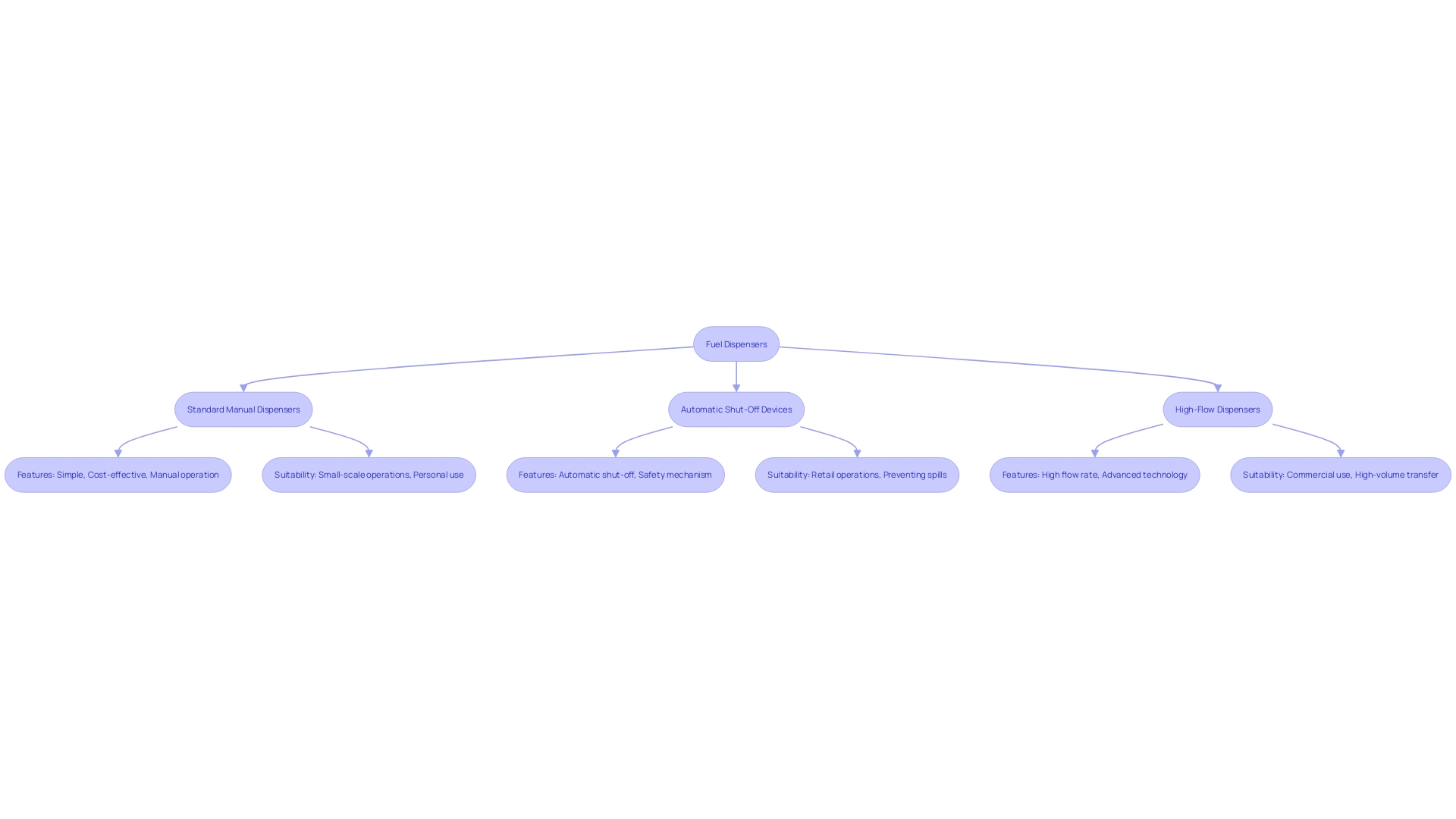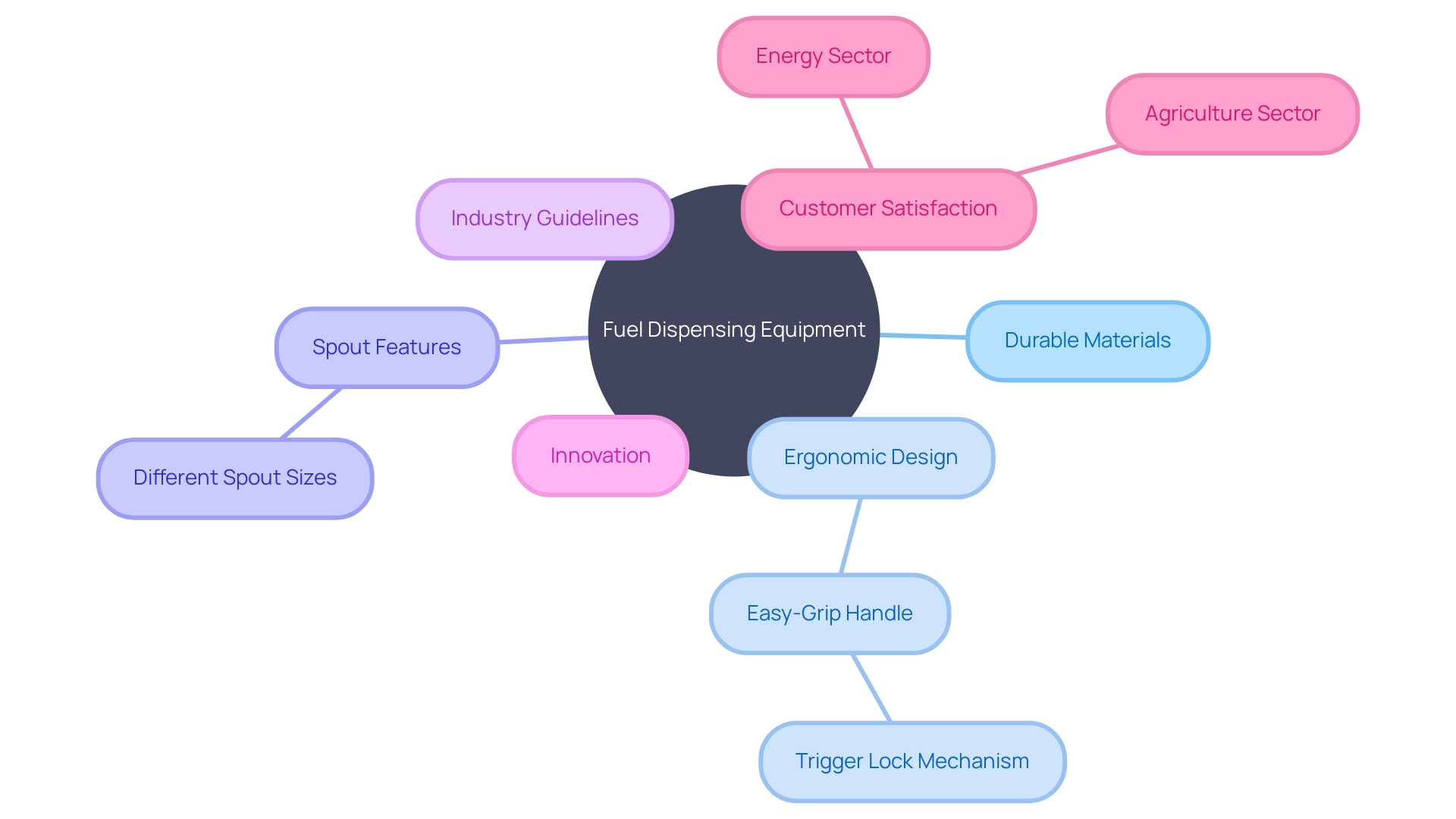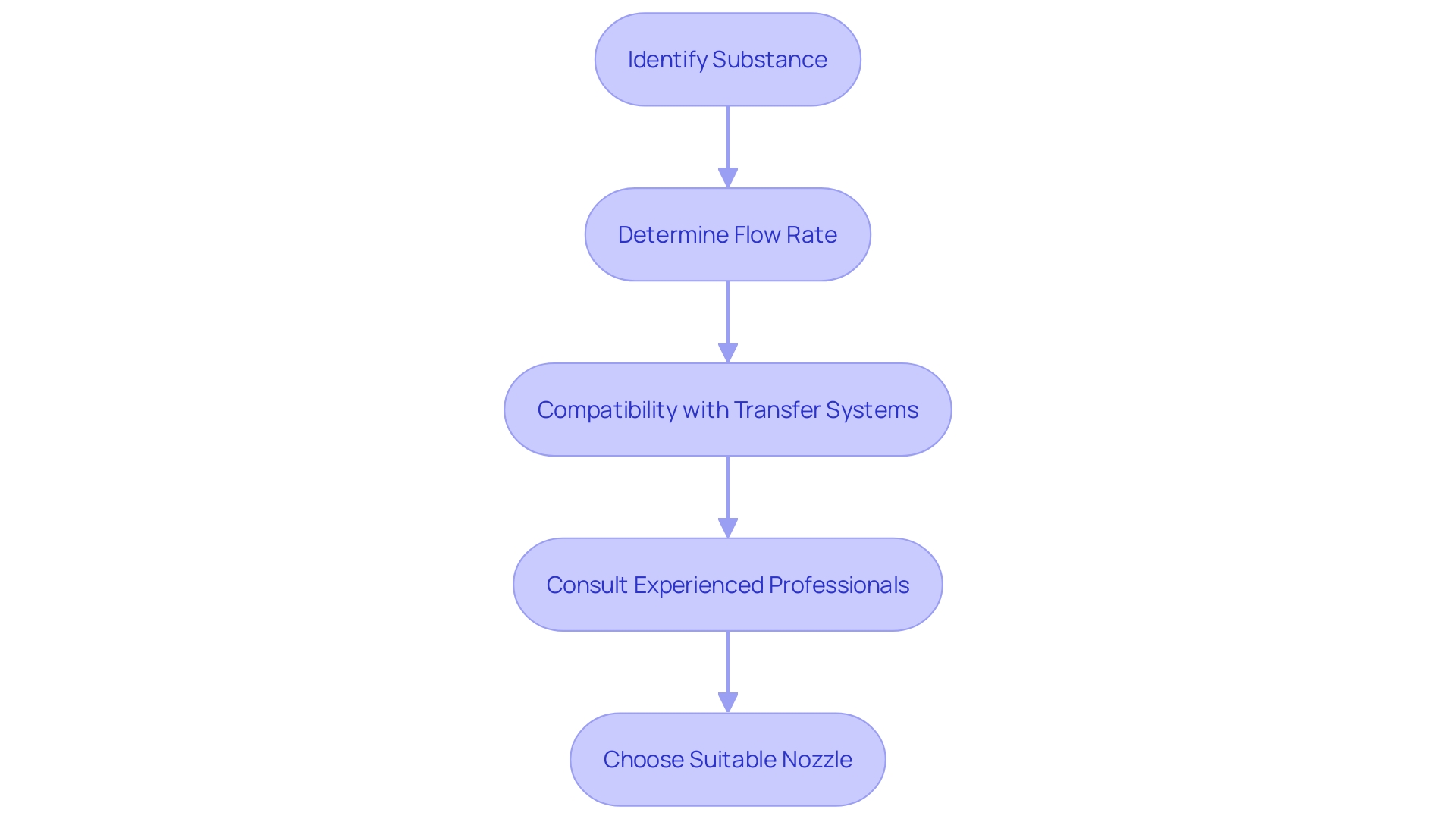Introduction
Fuel nozzles are a critical component of fuel transfer and dispensing systems, and choosing the right one is vital for efficiency and safety. In this article, we will explore the different types of fuel nozzles available at Tractor Supply and their key features. We will also discuss the importance of selecting the right fuel nozzle for your specific needs and the safety considerations associated with their use.
Additionally, we will delve into installation and maintenance tips to ensure the proper functioning of fuel nozzles. Finally, we will examine the benefits of efficient fuel transfer and dispensing systems in advancing sustainable transportation technologies. Stay tuned to gain valuable insights into the world of fuel nozzles and their role in the renewable fuels industry.
Types of Fuel Nozzles Available at Tractor Supply
For professionals in the field of energy transfer and dispensing, choosing the right equipment is crucial to ensure efficiency and safety. 'Fuel dispensers, a crucial element of this equipment, come in various forms to cater to different requirements.'. Standard manual dispensers are a popular option because of their simplicity and cost-effectiveness. They are suitable for operations where precise control over liquid dispensing is needed and where automatic features are not critical. Alternatively, automatic shut-off devices include a safety mechanism that prevents excessive filling, thereby reducing the risk of spills and promoting environmental safety. High-flow dispensers are designed to deliver gasoline more quickly, which is particularly advantageous in high-capacity fueling scenarios like servicing large vehicles or equipment. Each type of fuel dispenser is designed with distinct characteristics to address particular operational demands and to streamline the fueling process in diverse settings.

Key Features of Fuel Nozzles
The selection of fuel dispensing equipment at Tractor Supply has been meticulously designed with the end-user in mind, addressing the multifaceted needs of modern fuel dispensing. Each sprayer is constructed with durable materials guaranteeing durability and toughness, even in the most challenging conditions. The ergonomic design is tailored for user comfort, which is crucial during extended use, and the easy-grip handle reduces hand fatigue, a key consideration highlighted by users in various customer feedback studies. A notable feature is the trigger lock mechanism which facilitates a continuous flow of energy source, providing efficiency and reducing operator workload. Furthermore, the presence of different spout sizes is not only a convenience but a requirement to accommodate the different flow rates and specifications needed for various types of energy, guaranteeing accurate and secure energy transfer in accordance with the most recent industry guidelines for effectiveness and connectivity. These advancements reflect a commitment to innovation and customer satisfaction, mirroring the industry-wide shift towards more reliable and user-friendly equipment in energy and agriculture sectors.

Choosing the Right Fuel Nozzle for Your Needs
When acquiring equipment for distributing fuel, one must carefully choose the suitable nozzle to meet the specific requirements of the operation. The decision depends on different factors like the kind of substance being dispensed, the required flow rate, and the compatibility with current substance transfer systems. Maintaining efficiency and reliability in the transfer of gasoline and other fluids requires crucial solutions engineered with precision. For instance, the adoption of cutting-edge motion and control technologies from industry leaders like Parker can be instrumental in enhancing performance. These technologies are designed to integrate seamlessly with a multitude of mobile, industrial, and aerospace applications, ensuring a high degree of precision and reliability. Moreover, the transition to cleaner energy sources is facilitated by advancements in cell and hydrogen technologies, as these eco-friendly alternatives offer a sustainable energy supply while mitigating environmental impacts. With organizations like the Center for Transportation and the Environment at the forefront of promoting sustainable transportation solutions, the significance of choosing the right equipment for distributing alternative energy sources is further underscored. It is crucial to involve experienced professionals in the industry who can offer customized advice on choosing a dispenser for the substance that is in line with your particular needs and promotes a greener, more effective, and eco-friendly operational setting.

Automatic vs. Manual Fuel Nozzles
The components, which are essential for transferring and delivering fuel, are available in two main types: automatic and manual. The automated version features an integrated shut-off mechanism that is activated when the tank reaches capacity, thus preventing the dangers linked to spillage caused by overfilling. On the other hand, manual dispensers require the operator to control and stop the flow of gasoline, providing a more interactive method for dispensing fuel. This distinction in dispenser capability accommodates different operational preferences and the level of control needed in various fueling environments. Companies like Parker, the global leader in motion and control technologies, emphasize the importance of precision-engineered solutions that contribute to safer, smarter, and more sustainable operations. Their expertise reflects a commitment to innovation that aligns with the values of integrity and leadership, mirroring the ethos of family-operated entities like Smoker Craft, which prides itself on delivering high-quality marine products. Given the escalating costs of fuel, the utilization of cutting-edge fueling apparatus, such as dispensers, assumes a crucial part in reducing ecological consequences and promoting a more sustainable tomorrow. The choice between automatic and manual dispensers should be guided by a comprehension of both operational requirements and environmental factors, guaranteeing a harmony between user-friendliness and ecological accountability.

Safety Considerations for Fuel Nozzle Use
Ensuring the efficiency and proper operation of nozzles is crucial in the transfer and handling of fuel. It is crucial to adhere to rigorous protocols, including establishing a proper grounding connection to prevent static electricity build-up, which could ignite flammable vapors. Operators must don personal protective equipment (PPE) to shield themselves from potential hazards. Precautionary measures must be taken to guard against open flames or sparks in areas where fuel is dispensed, like gasoline or diesel.
Apart from these measures, regular maintenance and comprehensive inspections are crucial for the longevity and dependable performance of fuel nozzles. This is akin to the meticulous care and attention given to the maintenance of complex aviation systems, such as the Airbus A380. Despite the A380's advanced technology and size, ensuring its well-being and proper functioning is paramount, as evidenced by the incident with Qantas Flight 32. A seemingly small mechanical issue with one of its engines led to a near-disaster, underscoring the importance of rigorous checks and balances.
In the realm of aviation, the stakes are high, and the industry's commitment to security is unwavering, as demonstrated by Boeing's involvement in continuous safety improvements and accident investigations. The company's integration of human factors expertise into their risk management practices highlights the importance of anticipating and mitigating potential hazards. Similarly, in fuel handling, continuous improvement and adherence to the highest security standards are non-negotiable to prevent accidents and ensure secure operations.
The dedication to security expands beyond aviation to other sectors, including the energy industry, where the adoption of renewable energy technologies is increasing. For instance, utility-scale battery energy storage systems are increasingly common and are subjected to strict standards to ensure the protection of both workers and the environment. Just like the thorough supervision of equipment for delivering energy, the energy industry acknowledges that safety and effectiveness are crucial for the successful adoption and functioning of new technologies.
Installation and Maintenance Tips
Ensuring the proper functioning of fuel transfer and dispensing equipment, such as fuel delivery devices, is paramount. A secure attachment of the device to the transfer system is essential, along with the maintenance of tight connections to prevent leaks or accidents. It is advisable to conduct regular inspections for signs of wear and tear, and to clean the nozzle when needed. Following the manufacturer’s specifications for maintenance, including lubrication, helps to maintain the equipment’s performance and extend its service life. Moreover, adopting a proactive approach to system checks rather than a reactive one after problems have occurred can save time and costs while enhancing safety.
Benefits of Efficient Fuel Transfer and Dispensing
The enhancement of transferring and distributing fuel is not only about effectiveness; it is a crucial component of promoting sustainable transportation technologies. High-quality nozzles and well-designed dispensing equipment are pivotal in enhancing productivity and reducing environmental impact. By minimizing spills, leaks, and the risk of overfilling, operations can achieve a significant reduction in energy wastage. This attention to detail in the fueling process is reflected in the multi-staged upgrade journey undertaken by John Dee, where an initial analysis of current and future requirements informed the tailored design of their system, leading to improved tracking, accuracy, speed, and safety.
Innovative solutions in the energy sector, such as hydrogen cells, are setting a precedent for clean energy sources. These cells, which convert hydrogen into electricity, provide continuous power as long as a source of energy is available, positioning hydrogen as a viable, sustainable energy option. The transportation sector's move towards such technologies is supported by organizations like the Center for Transportation and the Environment (CTE), which focuses on reducing the environmental footprint of transportation through the deployment of advanced solutions.
Embracing technological advancements, Autofuel, a pioneer in fueling technology, reflects on a decade of success and ongoing efforts to revolutionize the refueling experience. The company's approach to automating the refueling process, without the need to discard existing equipment, exemplifies the cost-effective adoption of new technologies.
Moreover, the transition to electric forklifts in logistics and warehousing signifies the growing preference for electricity as the chosen energy source. The efficiency gains from using electric-powered hydraulic systems underscore the potential for electric mobility solutions to reshape industries.
Industry experts, such as Adrian Tolson from 2050 Marine Energy, stress the significance of adjusting supply chains for energy sources to the changing environment of decarbonization in transportation. The insights from such experts, combined with the latest environmental statistics highlighting the need for cleaner transport options, underscore the pivotal role of efficient fuel transfer and dispensing systems in achieving a more sustainable future for the transportation sector.
Conclusion
In conclusion, choosing the right fuel nozzle is vital for efficient and safe fuel transfer and dispensing. Tractor Supply offers a range of options, including manual, automatic, and high-flow nozzles, designed for precise control, safety, and high-volume fueling.
Factors like fuel type, flow rate, and compatibility with existing systems should be considered when selecting a fuel nozzle. Precision-engineered solutions from industry leaders like Parker enhance performance and reliability. Advancements in fuel cell and hydrogen technologies support the transition to cleaner energy sources.
Safety is paramount in fuel nozzle use, with proper grounding, personal protective equipment, and vigilance against open flames or sparks. Regular maintenance and inspections ensure reliable performance.
Proper installation and maintenance of fuel nozzles, including secure attachment and tight connections, prevent leaks and accidents. Regular inspections, cleaning, and following manufacturer specifications extend the nozzle's service life.
Efficient fuel transfer and dispensing systems are essential for advancing sustainable transportation technologies. By minimizing fuel wastage through spill prevention and overfilling mitigation, operations can reduce environmental impact. Embracing automation and electric mobility solutions further enhance efficiency and sustainability.
In conclusion, selecting the right fuel nozzle, prioritizing safety, and proper maintenance are crucial for efficient and sustainable fuel transfer and dispensing operations. By making informed choices and adopting innovative solutions, we can contribute to a cleaner and more efficient future in the transportation sector.




